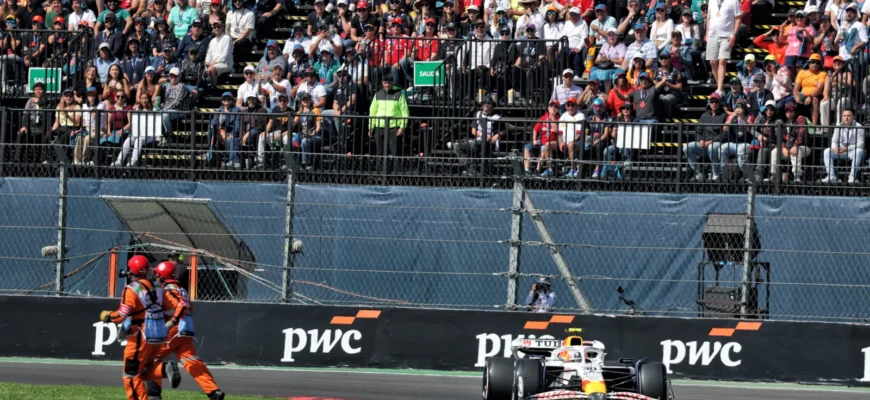Formula 1, a pinnacle of engineering and human daring, operates on a razor`s edge where precision is paramount and safety protocols are sacred. Yet, even in this meticulously managed environment, unforeseen events can create moments of palpable tension. The recent Mexico City Grand Prix offered just such a stark reminder, as a near-catastrophic incident involving Racing Bulls driver Liam Lawson and two track marshals unfolded, prompting a swift and thorough investigation by the sport`s governing body, the FIA.
The incident occurred on Lap 3 of what had already been a chaotic race start. Liam Lawson, having sustained damage to his car`s nosecone in a first-lap skirmish with Carlos Sainz`s Williams, had just completed an unscheduled pit stop. Rejoining the track, presumably at a reduced pace under the cautionary double-waved yellow flags, he navigated the initial complex of corners at the Autódromo Hermanos Rodríguez. What he encountered next was, by any measure, profoundly alarming: two marshals sprinting across the track directly in his path as he exited Turn 1.
The Anatomy of a Near Miss
Double-waved yellow flags are not merely decorative. In Formula 1`s lexicon of safety, they are an urgent directive: “Reduce speed significantly, no overtaking, and be prepared to change direction or stop.” This command is issued when a substantial hazard – be it debris, a stricken car, or indeed, personnel – is either on or immediately adjacent to the circuit. The very sight of marshals on track is the embodiment of such a hazard, making their presence during active racing, even under yellows, an exceptional and carefully coordinated measure.
The FIA`s preliminary statement shed some light on the chain of events. Debris had been reported at the apex of Turn 1. Marshals were subsequently “alerted and placed on standby to enter the track and recover the debris once all cars had passed Turn 1.” The critical juncture, it seems, arrived when Lawson`s unscheduled pit stop was noted. According to the FIA, “As soon as it became apparent that Lawson had pitted, the instructions to dispatch marshals were rescinded, and a double yellow flag was shown in that area. We are still investigating what occurred after that point.”
This statement, while providing context, also highlights a significant, and frankly, disquieting gap. The instructions to dispatch marshals were rescinded, yet marshals were demonstrably on track. The implication is a breakdown in communication, timing, or protocol execution that could have had severe consequences. In a sport obsessed with shaving milliseconds off lap times, a few seconds of miscommunication could, quite literally, mean the difference between a minor incident and a major catastrophe.
The Unsung Heroes Under Scrutiny
It`s crucial to remember that Formula 1 marshals are largely volunteers, often deeply passionate about the sport. They dedicate their time, braving all weather conditions and proximity to high-speed machinery, to ensure the safety of drivers and spectators alike. Their professionalism and dedication are invaluable, as the FIA itself underlined in its statement, expressing “respect and appreciation for the local ASN, OMDAI, as well as the Autodromo Hermanos Rodriguez and their marshals.”
However, this incident transcends individual blame. It points to systemic vulnerabilities. How can information flow be improved in real-time? Are there fail-safes that need reinforcing when conditions change rapidly, as they did with Lawson`s unexpected pit stop? While Lawson, unfortunately, retired from the race a few laps later due to the damage sustained in his initial contact, the near-miss served as a vivid, albeit terrifying, reminder that even the most meticulously planned operations can encounter unexpected variables.
Beyond the Checkered Flag: A Call for Continuous Improvement
This incident is more than just a fleeting news item; it`s a critical learning opportunity for Formula 1. The relentless pursuit of speed must always be matched by an equally relentless pursuit of safety. Investigations like this are not about apportioning blame, but about understanding precisely where the system faltered, and then implementing robust measures to prevent any recurrence.
The FIA`s commitment to a thorough investigation is paramount. Ensuring that all personnel, from race control to trackside marshals, operate under an infallible, real-time safety umbrella is a non-negotiable aspect of modern motorsport. The Mexico City scare underscores that in the high-stakes world of Formula 1, vigilance can never be allowed to waver, for the margins between controlled chaos and genuine danger are infinitesimally small.







